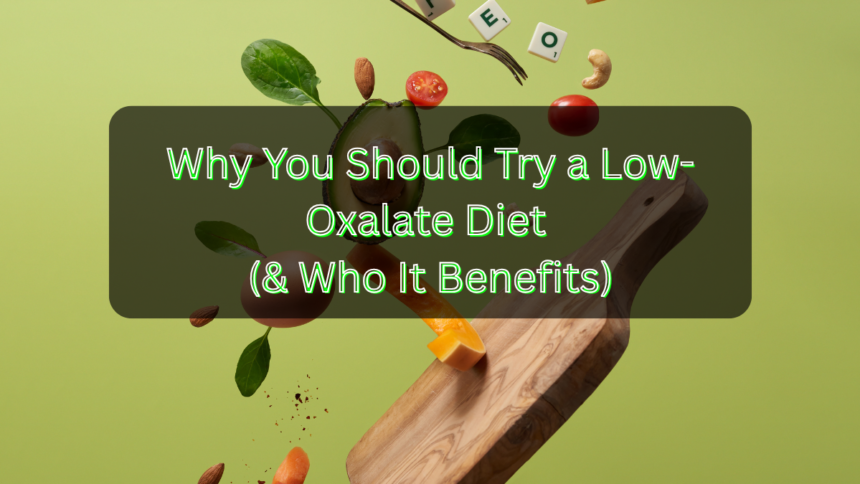Low-Oxalate Diet
If you’ve ever dealt with kidney stones, chronic inflammation, or mysterious joint pain, you may have heard about oxalates—and how reducing them in your diet could help. But what exactly are oxalates, and who should consider cutting back?
In this post, we’ll break down everything you need to know about a low-oxalate diet, including its benefits, who it helps the most, and practical tips to get started.
What Are Oxalates?
Oxalates (or oxalic acid) are naturally occurring compounds found in many plant-based foods. While they’re not inherently harmful, high levels can bind with calcium in the body, forming crystals that may contribute to kidney stones, inflammation, and other health issues.
Some common high-oxalate foods include:
- Spinach
- Almonds
- Beets
- Sweet potatoes
- Chocolate
- Tea
Not everyone needs to avoid oxalates, but for some people, reducing them can make a big difference in how they feel.
Who Benefits from a Low-Oxalate Diet?
Video Credits
1. People Prone to Kidney Stones
Kidney stones are one of the most well-known issues linked to high oxalate intake. When oxalates bind with calcium in urine, they can form painful stones. If you’ve had kidney stones before, a low-oxalate diet may help prevent recurrence.
Tip: Drink plenty of water to help flush out oxalates and reduce stone risk.
2. Those with Chronic Inflammation or Joint Pain
Some research suggests that oxalates may contribute to inflammation, particularly in people with conditions like arthritis or fibromyalgia. While more studies are needed, many report reduced pain and stiffness after lowering oxalate intake.
Tip: Keep a food journal to track if high-oxalate foods worsen your symptoms.
3. Individuals with Gut Health Issues
If you have leaky gut syndrome, Crohn’s disease, or other digestive disorders, oxalates might aggravate your symptoms. A damaged gut can absorb more oxalates, increasing the risk of kidney stones and systemic inflammation.
Tip: Pair high-oxalate foods with calcium-rich options (like dairy) to reduce absorption.
4. People with Vulvodynia or Interstitial Cystitis
Some women with vulvodynia (chronic vulvar pain) or interstitial cystitis (painful bladder syndrome) find relief on a low-oxalate diet. Oxalate crystals may irritate sensitive tissues, so reducing intake could ease discomfort.
Tip: Work with a healthcare provider to tailor the diet to your needs.
5. Those with Autoimmune or Metabolic Conditions
Emerging research suggests oxalates may play a role in mitochondrial dysfunction and autoimmune flare-ups. While evidence is still developing, some people with Lyme disease, Hashimoto’s, or chronic fatigue report improvements on a low-oxalate diet.
Tip: Focus on nutrient-dense, low-oxalate foods like cauliflower, zucchini, and pasture-raised meats.
How to Start a Low-Oxalate Diet
1. Know Which Foods to Limit (and Which to Enjoy)
High-oxalate foods to reduce:
- Spinach, Swiss chard
- Nuts (almonds, cashews)
- Rhubarb, beets
- Dark chocolate
- Soy products
Low-oxalate alternatives:
- Kale, lettuce
- Macadamia nuts, pecans
- Apples, berries
- White chocolate (in moderation)
- Grass-fed meats, wild-caught fish
2. Cook Smart to Reduce Oxalates
- Boiling vegetables can lower oxalate content (discard the water).
- Soaking nuts and legumes before eating reduces oxalates.
- Pair high-oxalate foods with calcium (e.g., spinach with cheese) to block absorption.
3. Stay Hydrated
Water helps flush out excess oxalates, reducing the risk of kidney stones. Aim for at least 2 liters per day.
4. Monitor Your Symptoms
Track how you feel after meals. If joint pain, fatigue, or digestive issues improve, oxalates might have been a trigger.
Common Myths About Oxalates
❌ Myth: All plant foods are high in oxalates.
✅ Truth: Many fruits and veggies (like cucumbers and avocados) are low-oxalate.
❌ Myth: A low-oxalate diet is necessary for everyone.
✅ Truth: Only certain individuals (like those with kidney issues) need to restrict oxalates.
❌ Myth: Calcium should be avoided to prevent kidney stones.
✅ Truth: Calcium binds oxalates in the gut, preventing absorption—so don’t skip it!
Final Thoughts: Is a Low-Oxalate Diet Right for You?
If you struggle with kidney stones, chronic pain, or gut issues, experimenting with a low-oxalate diet could be worthwhile. Start by cutting back on the highest-oxalate foods and see if symptoms improve.
Remember, balance is key—you don’t need to eliminate oxalates completely unless medically advised. Work with a nutritionist or doctor to tailor the approach to your needs.
Have you tried a low-oxalate diet? Share your experience in the comments!


